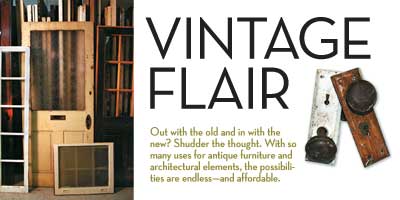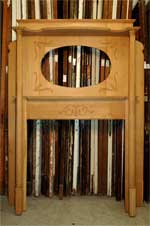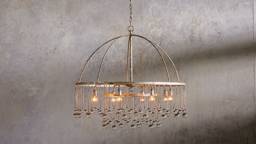|
What do you mean by "antique"? So where can I find these pieces? Flea markets, antique shows, consignment shops and salvage yards are other obvious places to shop for vintage pieces. But what's not so obvious is how to choose items that are worth the hunt. Pay attention to elements and furniture with interesting shapes and patterns. Take the time to appreciate them for their original function, then think about how you can use theme in a completely new way. Would a wrought-iron gate work just as well as a wall ornament? Could an old-fashioned door be converted into a tabletop? Can you hang that window frame from your loft beams as a room divider? And while it's nice to touch and feel the pieces before you buy, don't neglect the Internet. Though the information superhighway might seem like the last place you'd look for old relics, quite a few web sites are dedicated to recycled building materials and architectural elements. The California Integrated Waste Management Board site (www.ciwmb.ca.gov/reuse/ links/building.htm) provides an alphabetized list of companies that specialize in salvaged building materials. And Vintage Timberworks (www.vintagetimber.com) focuses on recycled old-growth lumber. The wood can come "as is" with history marks, or can be reworked to your specification. These sites are wonderful ways to generate ideas for your home. While shopping, always make sure you consider each item's scale (height, width and depth) when determining how it will work in your homeÑespecially when you can't see the piece in person. Once I can find it, how do I use it? Old window frames and doors (both wooden and wrought iron) have a variety of uses. Any glass shop can custom-cut mirrors or colored glass to fit in empty panes. With or without glass, hang the window or door as an artistic element in your room. Or you can turn an interesting wood or wrought-iron door lengthwise and hang above your bed as headboard. (A pair of windows could substitute for this decorative treatment, too.) In a fairly open, loft-like space, a vintage window frame hanging from the ceiling or positioned between a sofa and a console table can serve as a unique room divider. Pedestals, wellheads, oversized ceramic vessels make wonderful table bases. Depending on their size, use them as side tables, coffee tables and even kitchen tables. Glass is a great table topper because it showcases the base beneath in all its glory. However, you also can use stone (depending on how sturdy your base is) and woodÑeven an old window or door—but make sure it's high enough to offer plenty of sitting and knee room. Industrial metal lockers can be repainted a cheery color and find a new home in the mudroom as storage for athletic equipment, canned goods and cleaning supplies. In the bathroom they can hold towels or paper goods. Recycled furniture gets a new life with a fresh coat of paint and new hardware. Just as paint color is rejuvenating for walls, so is changing the hardware on furniture. Hardware itself is an oft-overlooked way to add depth and interest to a space. Think vintage glass doorknobs, cabinet pulls, hooks and door knockers. Whether used as artistic flair in your home or for the function they were genuinely intended, hardware can immediately jazz up your space for very little money. Is there a right and wrong way to decorate with vintage pieces? Right: Creativity is always right when recycling antique pieces. Complements from house guests always signal when you've got it right. But most of all, the desire to go out hunting for more because your first antique/vintage endeavor turned out marvelously means you did it right. Jennifer Larsen is a Chicago-based interior designer. |
Vintage Flair
With so many uses for antique furniture and architectural elements, the possibilities are endless—and affordable.
Written by
Log Home Living Editors





 Why this interest in "old"?
Why this interest in "old"?






